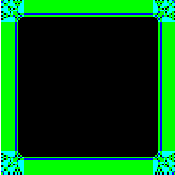I've been reading about the Abelian Sandpile Model and noticed the identity element of the sandpile group on the square has self-similar components.

The sandpile group of the 198x198 square of height 4 above is a finite abelian group. However, the sandpile corresponding to elements of this group can be fractal. Where is the complexity coming from?
Also, how does can you find the identity element (say, with a computer)?

